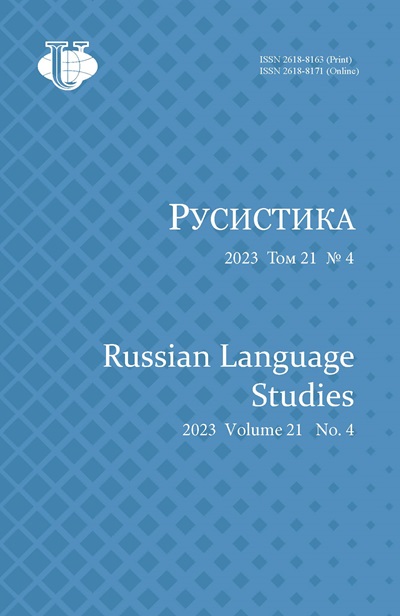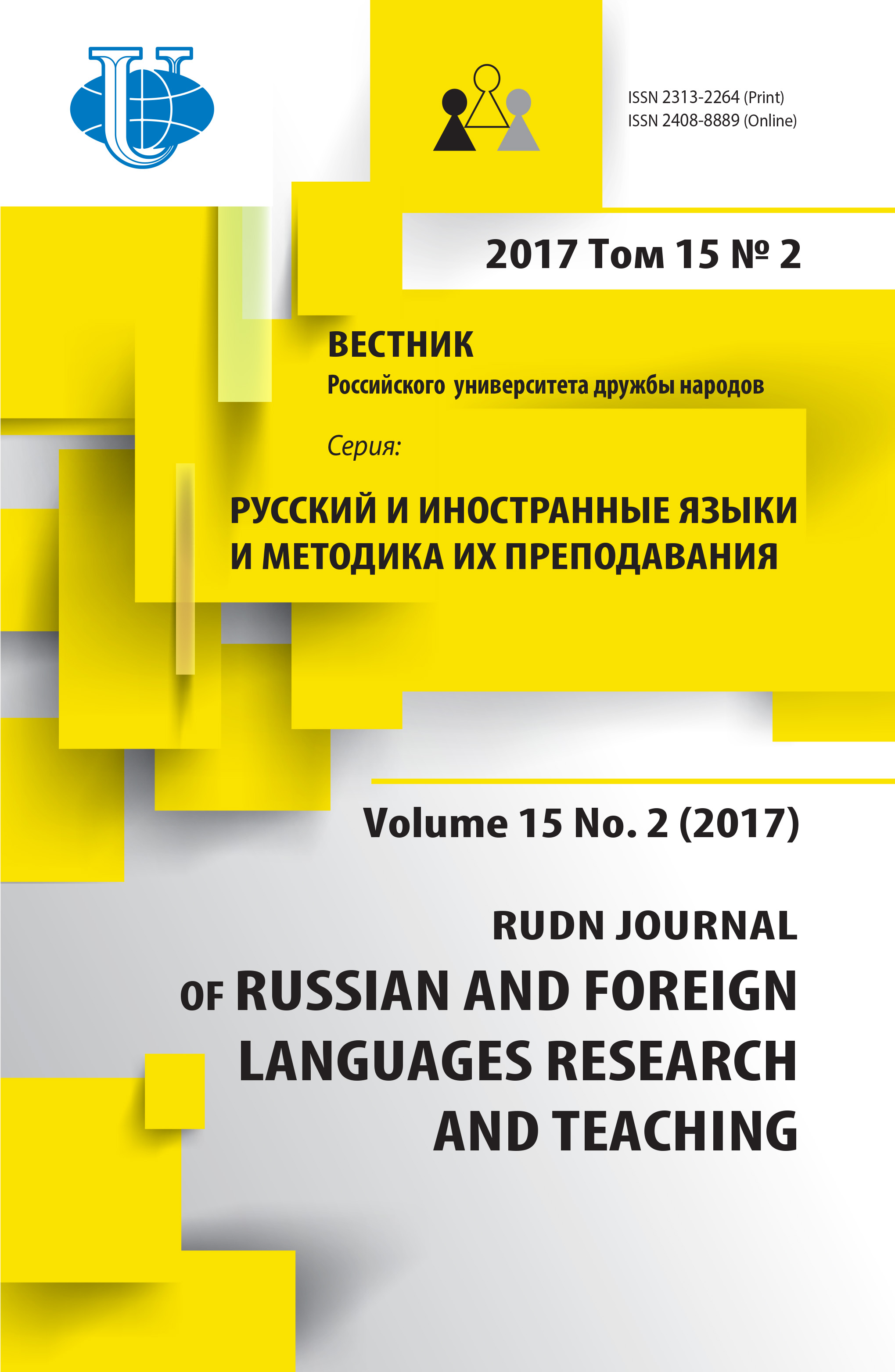CULINARY CULTURE CODE IN THE SECONDARY NAMING OF THE RUSSIAN AND CZECH LANGUAGES: LINGUISTIC AND METHODOLOGICAL ASPECTS
- Authors: Markova E.M1,2
-
Affiliations:
- Moscow State Regional University
- Ss. Cyril and Methodius University
- Issue: Vol 15, No 2 (2017)
- Pages: 152-174
- Section: Articles
- URL: https://journals.rudn.ru/russian-language-studies/article/view/16195
- DOI: https://doi.org/10.22363/2313-2264-2017-15-2-152-174
Cite item
Full Text
Abstract
The article considers the realization of one of the most active and stable metaphorical language models based on the development of secondary meanings of the Slavs’ food names and known as the culinary code, from the linguocultural and linguo-didactic standpoint. Culinary cultural code “encodes” our understanding of the world through food images having names. The author’s goal is to reveal the general and the specific in the development of secondary names of food; consider the food names specific for the ethnic cultures being compared, tracing their fate in the secondary semiosis - in metaphores, similes, phraseological expressions, proverbs - on the material of nouns in two Slavic languages, Russian and Czech. The article concludes that the facts of secondary naming transmitting culinary code often carry culturological information, objectify particular perceptions of the world by different ethnic groups, even those going back to the common Proto-Slavic roots. Bilingual comparison of lexical units transmitting cultural code allows a certain way of organizing lexical material for it to be studied by non-Russian Slavic audiences. On the basis of the linguocultural analysis of food names in the two compared Slavic languages, the article offers linguo-didactic grouping of the vocabulary in their figuratve meanings, in accordance with the belonging to a particular culture code. This will ensure effective mastering of the vocabulary of a certain thematic group not only in the denotative, but also in the conceptual meaning, making it possible to comprehend the culture, transmitted by the closely related language under study, in comparison with the native culture.
About the authors
Elena M Markova
Moscow State Regional University; Ss. Cyril and Methodius University
Author for correspondence.
Email: elena-m-m@mail.ru
Doctor of Philology, Professor of the Department of Russian as a Foreign Language at Moscow State Regional University; Professor of the Department of Russian Studies at St. Cyril and Methodius University in Trnava (Slovakia). Honorary Worker of Higher Education of the Russian Federation
Radio str., 10A, Moscow, Russia, 105005; Trnava, SlovakiaReferences
- Gudkov D. Units of Cultural Codes: Problems of Semantics // Language Consciousness, Communication: Coll. of articles. Vol. 26. M., 2004: 39—51. (In Russ.)
- Alefirenko N. “Living” Word. Problems of Functional Lexicology. M.: Flinta-Nauka, 2009: 342 pp. (In Russ.)
- Vorobyev V. Linguistic and Cultural Studies. M.: RUDN Publishing House, 2008: 340 p. (In Russ.)
- Krasny’h V. “Insider” Among Aliens: Myth or Reality? M.: Gnozis, 2003. 374 p. (In Russ.)
- Kovshova M. Interaction of Language and Culture in Action: on the Example of Cultural Interpretation of Phraseological Units // Life Giving Connection Between Language and Culture. Vol. 1: Language. Mentality. Culture. Moscow-Tula, 2010: 27—33. (In Russ.)
- Teliya V. Russian Phraseology. Semantic, Pragmatic and Linguistic and Cultural Aspects. M., 1996: 284 p. (In Russ.)
- Tokarev G. Linguistic and Cultural Studies. Tula: Publishing House of Tolstoi Tula State Ped. Univ., 2009: 135 p. (In Russ.)
- Shestak L. Russian Linguistic Personality: Codes of Figurative Thesaurus Verbalization: monograph. Volgograd: Peremena, 2003: 312 p. (In Russ)
- Mlacek J., Baláková D., Kováčová V. Vývin súčasnej frazeol gie: východiská, podoby, uplatňovanie, akceptácia. Ružomberok: Vyd-vo Michala Vaška (Slovensko), 2009.
- Sipko J. Teoretické a sociálno-komunikačné východiská lingvokulturol gie. Prešov: FF PU, 2011.
- Arutyunov S. Traditional Food as an Expression of Ethnic Identity / S. Arutyunov, T. Voronina. M., 2001: 289 p. (In Russ.)
- Afonina A. Figurative Use of Linguistic Units of the Lexical-Semantic Field “Food” // MGOU Bulletin: Series “Linguistics”. M.: MGOU Publishing House, 2007 (1): 79—87. (In Russ.)
- Berezovich E. Russian Vocabulary on the Common Slavic Background: Semantic and Motivational Reconstruction. Moscow: Russian Foundation of Education and Science Promotion, 2014: 488. (In Russ.)
- Gachev G. Science and National Cultures. Rostov-on-Don: Publishing House of Rostov University, 2009. (In Russ.)
- Kapelyushnik E. Man through the Prism of the CulinaryCode of Culture // Bulletin of Tomsk State University (345), Tomsk, 2011: 11—14. (In Russ.)
- Tolstaya S. The Space of Word. Lexical Semantics in the Common Slavic Perspective. M.: Indrik, 2008. 528 p. (In Russ.)
- Fomina Z. Cultural and Gastronomic Senses in the European and Russian Linguistic Consciousness as a “World in Miniature” // Scientific Bulletin: Series “Modern Linguistic and Methodical-Didactic Research”. Voronezh, 2009. Vol. 1 (11): 11—24. (In Russ.)
- Yurina E. Tasty Metaphors: Food Tradition in the Mirror of Linguistic Images. Monograph. Kokshetau, 2013: 240 p. (In Russ.)
- Slavic Mythology. Encyclopedic Dictionary: 2nd ed. M., 2002. (in Russ.)
- Slavic Antiquity. Ethnolinguistic Dictionary. M., 1995. (In Russ.)
- Sreznevskij I. Materials for the Dictionary of the Old Russian Langiuage. M., 1958. (In Russ.)
- Machek V. Etymologický slovník jazyka českého. 5-e vydání. Brno, 2010. 866 s.
- Slovník nespisovné češtiny. 2 vyd. Praha, 2006.
- Mokienko V., Vurm A. Dictionary of Comparisons of the Russian Language. SPb., 2003. (In Russ.)
- Dal’ V. Explanatory Dictionary of the Great Russian Language. In 4 vol. M., 1978—1980. (In Russ.)
- Slovník české frazeologie a idiomatiky. 1. Přirovnání // F. ermák, J. Hronek a kol. Praha: Leda, 2009.
- Semenova M. Life and Beliefs of Ancient Slavs. SPb., 2001. (In Russ.)
- Niederle L., Slavic Antiquities. M.: Novy`j Akropol’, 2010: 742 p. (in Russ.)
- Slovník spisovné češtiny pro školu a veřejnost. Praha, 2003.
- Big Phraseological Dictionary of the Russian Language // Ed. by V. Teliya. M., 2006. (In Russ.)
- Fasmer M. Etymologial Dictionary of the Russian Language. In 4 vol. 4th ed. M., 2004. (In Russ.)
- Klégr A. Tezaurus jazyka českého. Praha, 2007.















